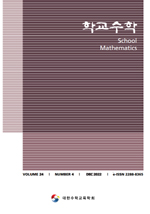2009 개정 초등학교 수학과 교육과정에서 주요 변화 내용 중 하나는 덧셈과 뺄셈의 지도를 네 자리 수의 범위에서 세 자리 수의 범위로 축소한 것이다. 이전 교육과정과 달리 2009 개정 시에는 세 자리 수 범위에서 덧셈과 뺄셈의 계산 원리를 파악하고 나면 그 원리를 일반화하여 네 자리 이상의 자연수의 덧셈과 뺄셈도 가능하다고 가정된 것이다. 이에 본 연구에서는 세 자리 수의 덧셈과 뺄셈 원리 이해가 네 자리 수의 덧셈과 뺄셈으로 확장될 수 있는지 파악함으로써 계산 원리의 일반화 가능성에 대해 논의하고자 하였다. 2015년과 2016년 2년에 걸쳐, 전국적으로 6개 시ㆍ도에 속한 6개 학교로부터 네 자리 수의 덧셈과 뺄셈까지 배운 5학년 339명(집단 2015)과 세 자리 수의 덧셈과 뺄셈까지만 배운 5학년 316명(집단 2016)을 표집하여 세 자리 수와 네 자리 수의 덧셈과 뺄셈 검사를 실시하고, 두 집단의 성취 수준 결과를 독립표본 t-검정을 통해 비교‧분석하였다. 연구 결과, 네 자리 수의 뺄셈에 대해 두 집단 간에 통계적으로 유의미한 차이가 있는 것으로 나타났고, 그에 대한 논의로부터 몇 가지 교수학적 시사점을 도출하였다.
This study aims to investigate the possibility of elementary students’ generalization from three-digit numbers to multi-digit numbers in principles for addition and subtraction. One of main changes was the reduction of range of numbers for addition and subtraction from four-digit to three-digit. It was hypothesized that the students could generalize the principles of addition and subtraction after learning the three-digit addition and subtraction. To achieve the purpose of this study, we selected two groups as a sampling. One is called ‘group 2015’ who learned four-digit addition and subtraction and the other is called ‘group 2016’ who learned addition and subtraction only to three-digit. Because of the particularity of these subjects, this study covered two years 2015~2016. We applied our addition and subtraction test which contains ten three-digit or four-digit addition and subtraction items, respectively. We collected their results of the test and analyzed their differences using t-test. The results showed statistically meaningful difference between the mean score of the two groups only for four-digit subtraction. Based on the result, we discussed and made some didactical suggestions for teaching multi-digit addition and subtraction.
I. 서론
II. 이론적 배경
III. 연구 방법
IV. 연구 결과
V. 논의 및 시사점
참고문헌
(0)
(0)
